New Possible's annual 'What Workers Want' survey anticipates further turbulence in the labour market, with 39% of UK employees considering a new job in the next 12 months - a 6% jump on the previous year.
Concern over job security is also on the rise, with 14% of employees believing they're at risk of redundancy. Meanwhile, pay expectations remain above inflation: on average, respondents consider a 7% pay rise ‘fair’ in 2025 - slightly down from 8% in 2024.
Demand for flexibility gathers momentum; a notable 59% of employees without flexible options plan to leave in the next year, up from 50% in 2024.
In this article, we’ll deep-dive into responses from 2,014 UK employees to uncover how they really feel about work. We’ll explore what’s driving them to seek new roles, highlight the benefits they value most, and examine overall wellbeing and job security trends heading into 2025.
Key takeaways
- 39% of UK employees say they’re likely to look for a new role in the next 12 months (up by 6% from 2024).
- Poor leadership and unhealthy culture remain the top reasons employees leave. Colleagues and flexibility are the top reasons they stay.
- On average, employees view a 7% pay rise in 2025 as ‘fair’ (down from 8% in 2024), with workers in hospitality, retail, and healthcare wanting the highest increases.
- 59% of employees without flexible work options are planning to leave within the next 12 months (up from 50% in 2024).
- Flexible hours (75%), remote work (62%), and extra holiday (48%) top the list of benefits that employee’s value most.
- 30% of employees report a decline in their wellbeing over the past year, with the greatest declines seen in the transport and logistics, IT, sales, and retail sectors.
- 14% believe they’re at risk of redundancy, with employees in banking and finance, creative arts, marketing, public services, and IT feeling least secure.
- Employees aged 35-44 are most likely to job-hunt (46%), driven by pay dissatisfaction and heavy workloads.
- Engineering, manufacturing, and charities report the highest employee satisfaction levels, while healthcare, retail, transport and logistics are least satisfied.
- Previously the most satisfied sector in 2024, IT now reports growing dissatisfaction, with particular frustrations around pay and work-life balance.
What motivates employees to stay in a role or jump ship?
To identify the key drivers that motivate employees’ decisions to stay or leave their jobs, we asked respondents of our ‘What Workers Want’ survey to tell us about the best and worst aspects of their jobs. The responses were then split into the following two groups and processed by our AI model:
Likely to leave: Those who said they are likely or very likely to leave their job in the next 12 months.
Likely to stay: Those who said they are likely or very likely to stay in their job.
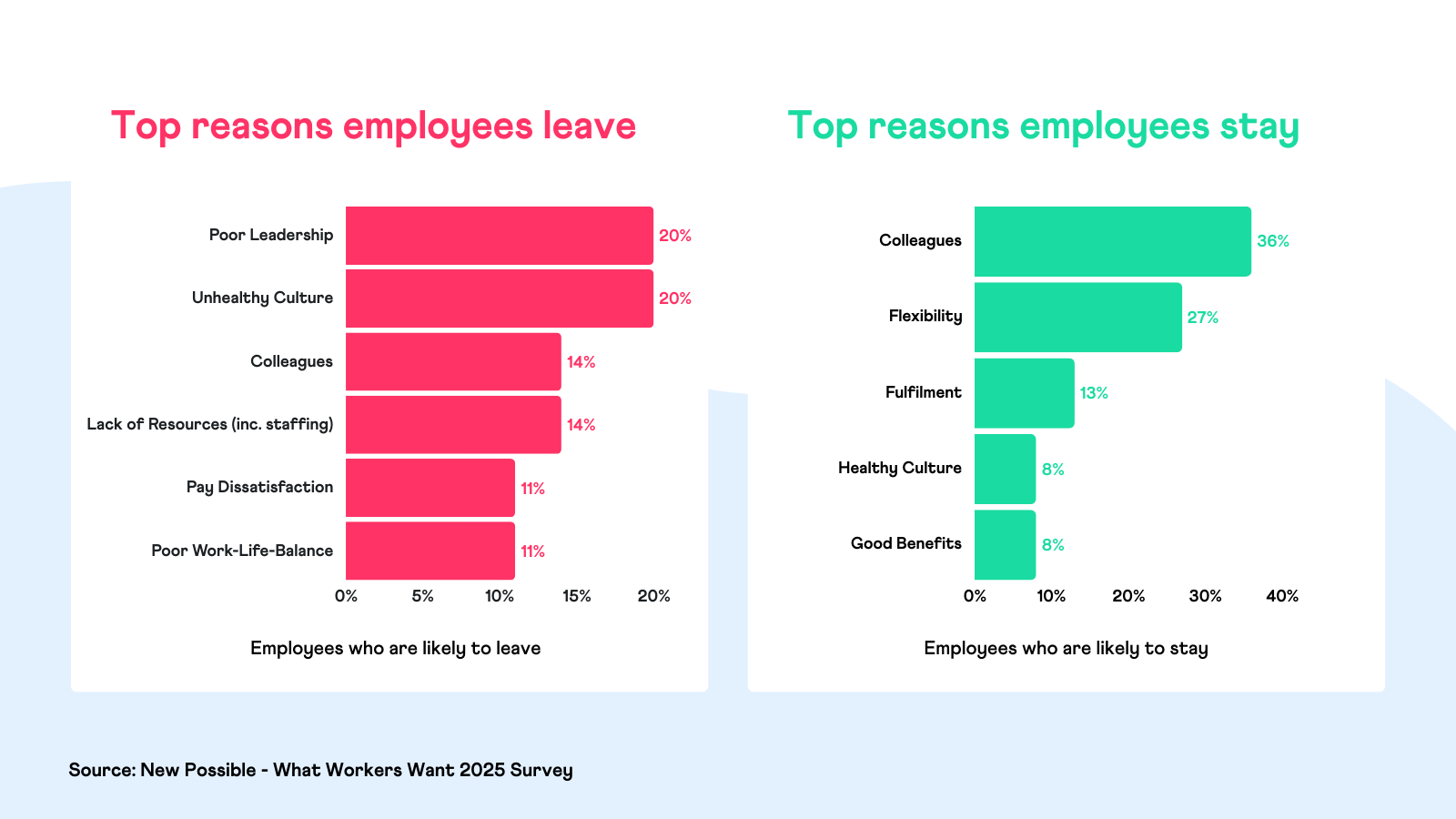
Dissatisfaction with leadership and culture are the top reasons employees leave
Poor leadership (inc. managers) and unhealthy culture are the key drivers behind employees leaving.
But what is meant by culture? Below we highlight the most common words used by employees to describe what culture means to them:
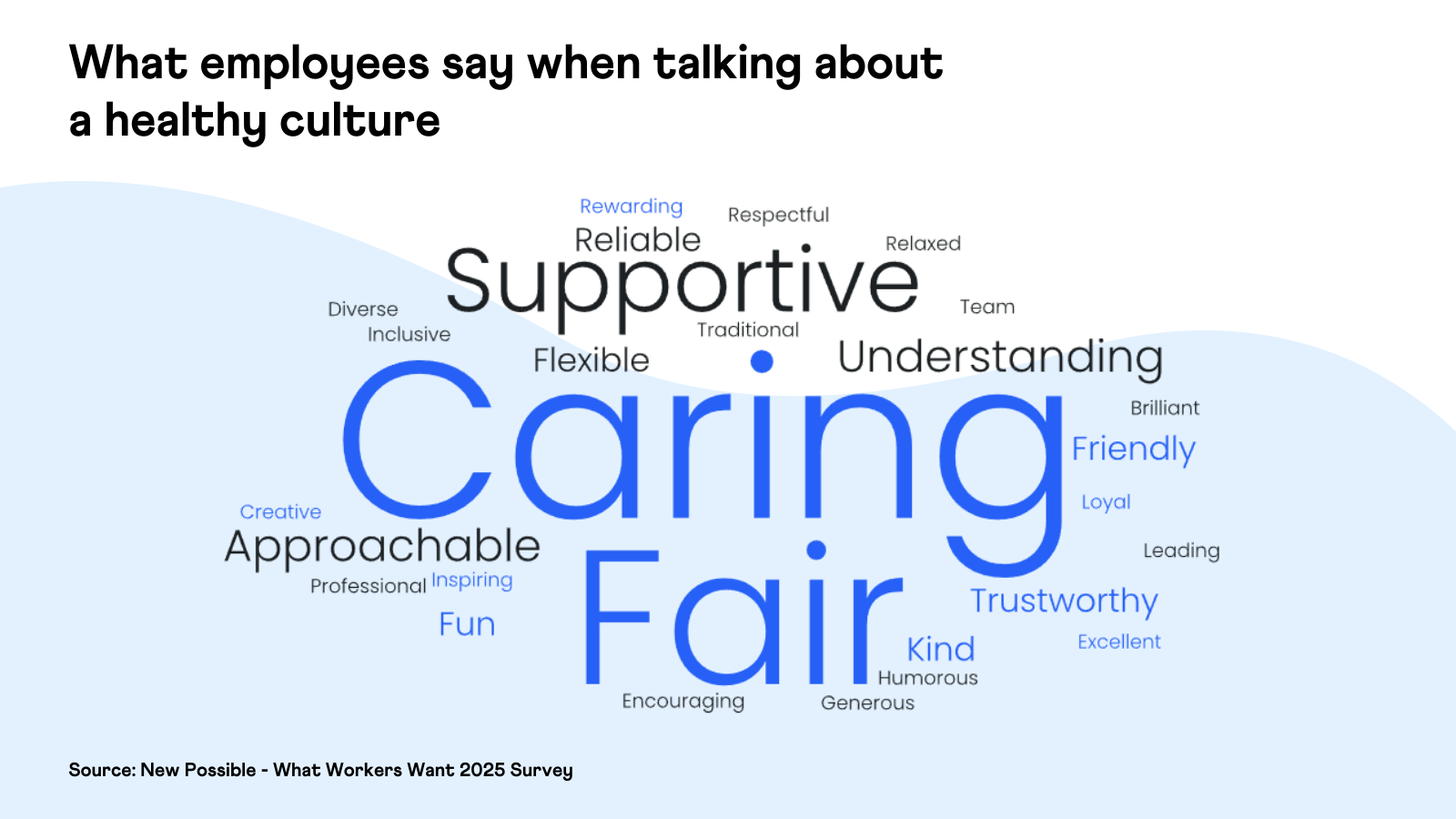
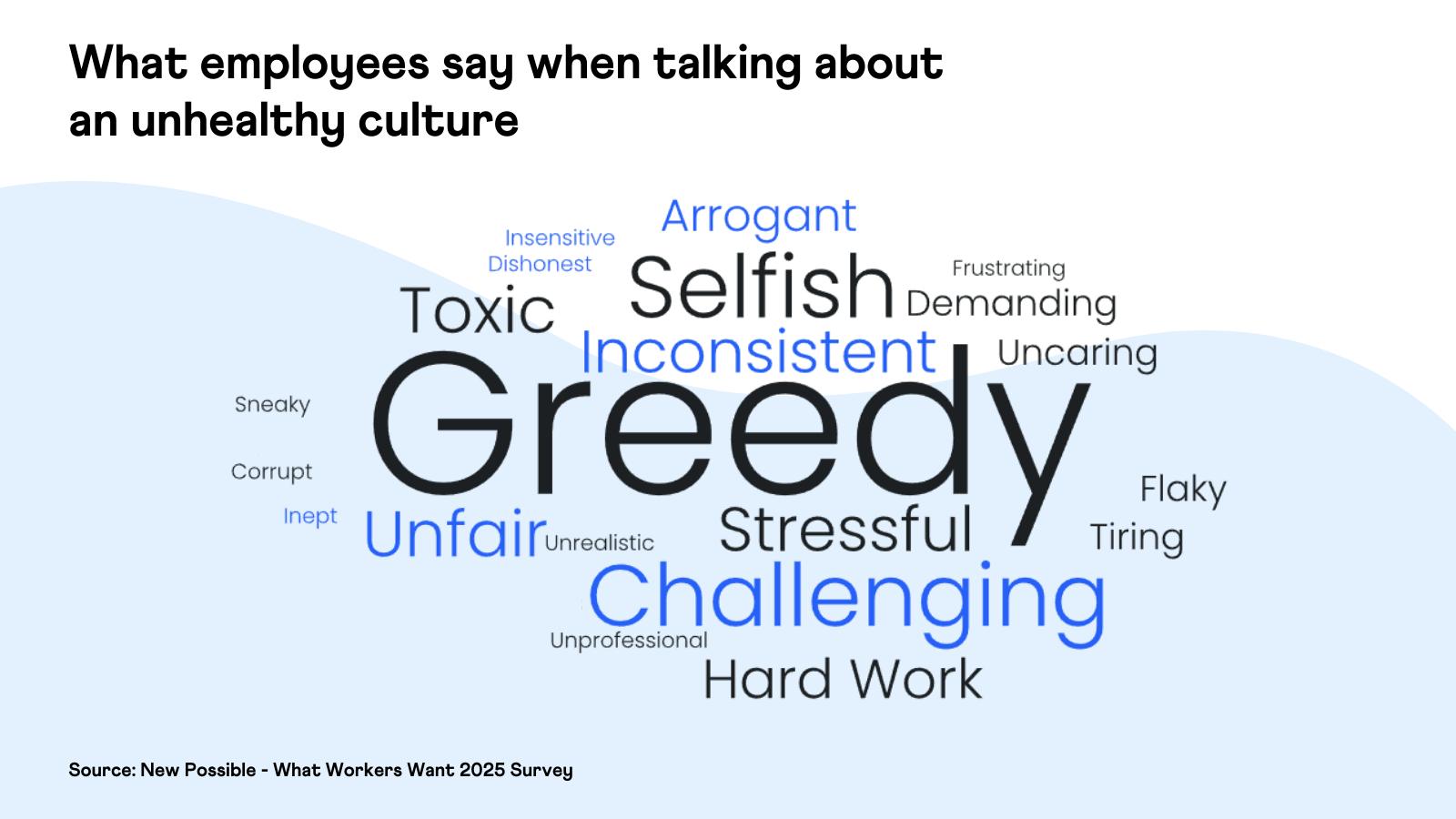
When describing a healthy culture, ‘caring’, ‘fair’ and ‘supportive’ are often used. In contrast, unhealthy cultures were most often described as ‘greedy’, ‘challenging’ and ‘toxic’ – with people frequently feeling undervalued.
Although a key theme, pay dissatisfaction played a slightly smaller role in 2025, with 11% of respondents citing it as a motivation for leaving (vs. 16% in 2024).
Employees were asked what they thought a ‘fair salary increase for 2025’ would be. Here’s what they said:
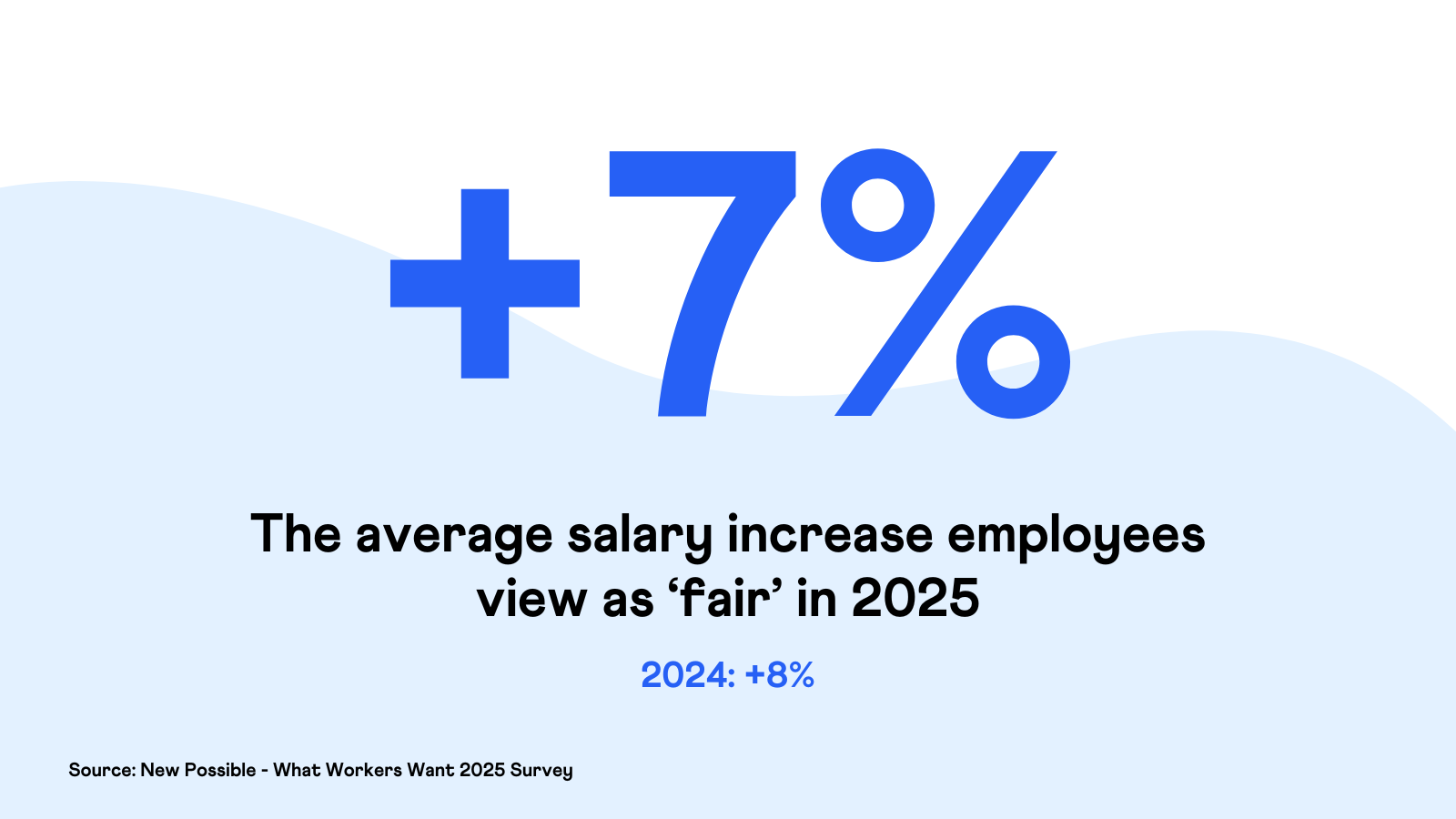
When asked what a ‘fair’ pay rise in 2025 should be, the average response was 7%, a slight decrease on 2024 (8%), although remaining significantly above the current inflation rate of 2.5%.
Sector-specific expectations were highest in hospitality (10%), retail (8%), and healthcare (8%), where lower average wages make workers particularly vulnerable to rising prices and interest rates. These sectors are also grappling with chronic staff shortages and disproportionate cost pressures from upcoming changes to employers’ national insurance contributions, creating a challenging environment for employers to navigate.
Lack of resources and poor work-life balance remain key frustrations
People often talked about ‘pressure’, ‘long hours’ and ‘feeling overworked’ – this feeling was strongest in the retail, education and IT sectors. Increased staffing and ‘greater flexibility’ were often suggested, with people also wanting more recognition.
This sentiment aligns with research by recruitment firm Robert Half, which found that 62% of employees are worried about being overworked this year as a hiring slowdown and tight budgets increase workloads.
These challenges are taking a noticeable toll on employee wellbeing. Over half (51%) of those considering leaving because of insufficient resources or poor work-life balance reported a decline in their wellbeing over the past year, compared with 30% of all respondents.
Colleagues and flexibility remain top reasons employees stay
Colleague relationships remain a key reason why employees stay, alongside flexibility in working hours and location.
We define flexibility as a way of working that suits an employee’s needs, for example having flexible start and finish times, or working from home.
Leaders who can maintain a strong team culture while offering flexibility are particularly well positioned to retain their people.
60% of employees say their employer offers flexible working
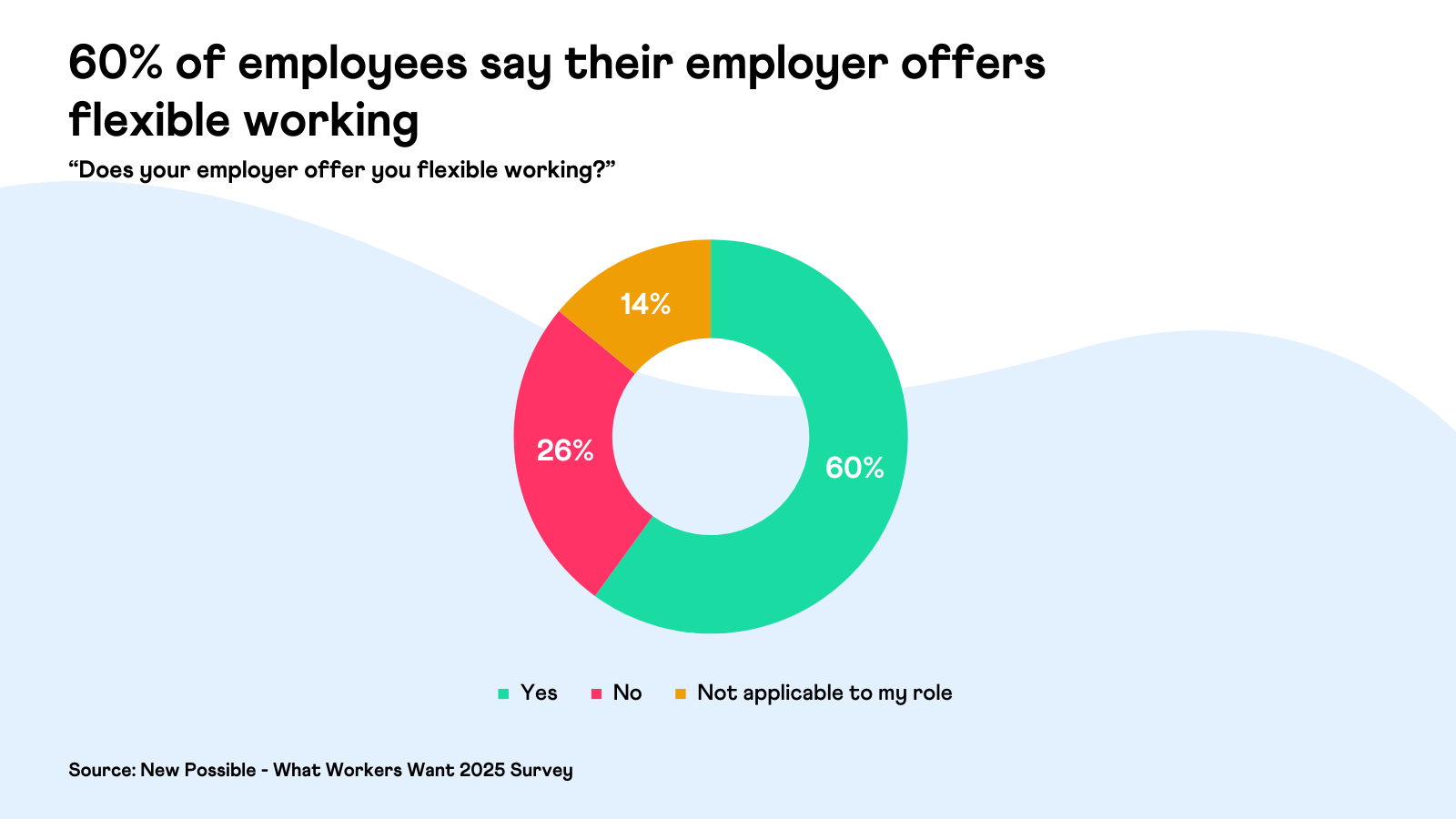
60% of respondents reported that their employer offers flexibility, up from 56% in 2024. In contrast, 26% said flexibility isn’t provided, and 14% said it doesn’t apply to their role.
59% of employees without flexibility plan to leave within a year, up from 50% in 2024
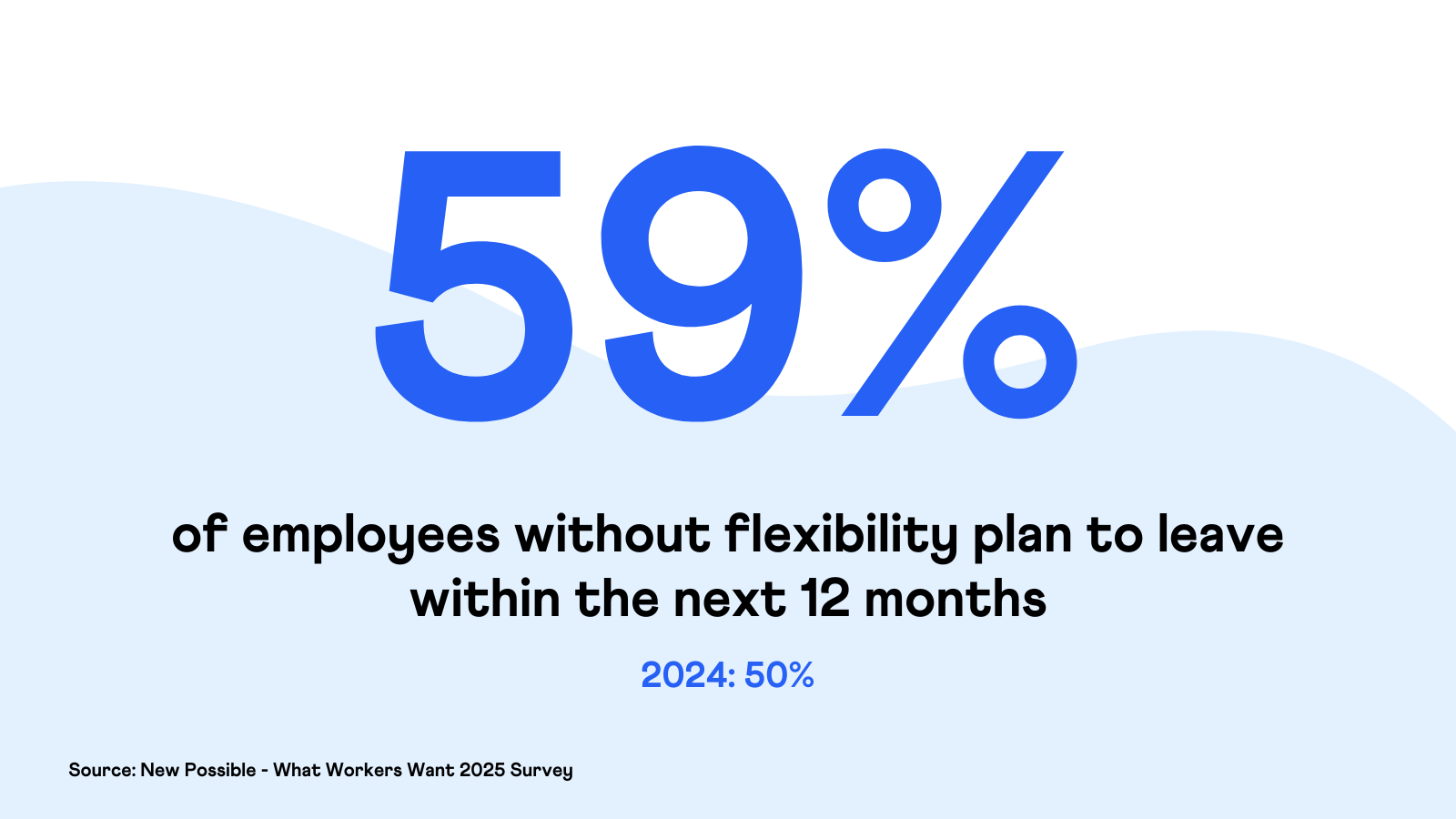
Pressure is mounting on organisations that fail to offer flexibility: 59% of employees without flexible work options plan to leave within the next 12 months, compared to 50% in 2024.
Further supporting this trend, a recent survey by IWG (as reported in The Guardian) found that two-thirds of recruiters have seen a surge in applicants looking for new roles after being mandated to work five days a week in the office.
Employees with flexible work options also feel more secure about their jobs - 13% of those with flexibility believe they're at risk of redundancy, compared to 18% of those without. Is this because organisations offering flexibility tend to be more successful? Or that organisations in distress are more likely to 'call to arms', and enforce a return to the office? We believe both factors play a role.
What other drivers are motivating employees to stay?
Fulfilling work: A job that’s interesting, varied, and purposeful is mentioned by 13% of employees who plan to stay.
Healthy culture: Culture is mentioned by 8% of employees who are likely to stay, vs. 20% who are likely to leave - underscoring it's importance as a hygiene factor. When culture is healthy, it’s often taken for granted, but when it’s lacking, employees are far more inclined to look elsewhere.
Good benefits: 8% of employees (vs. 9% in 2024) point to competitive benefits as a significant driver of retention.
Below, we explore which specific benefits employees value most.
75% of employees want greater flexibility
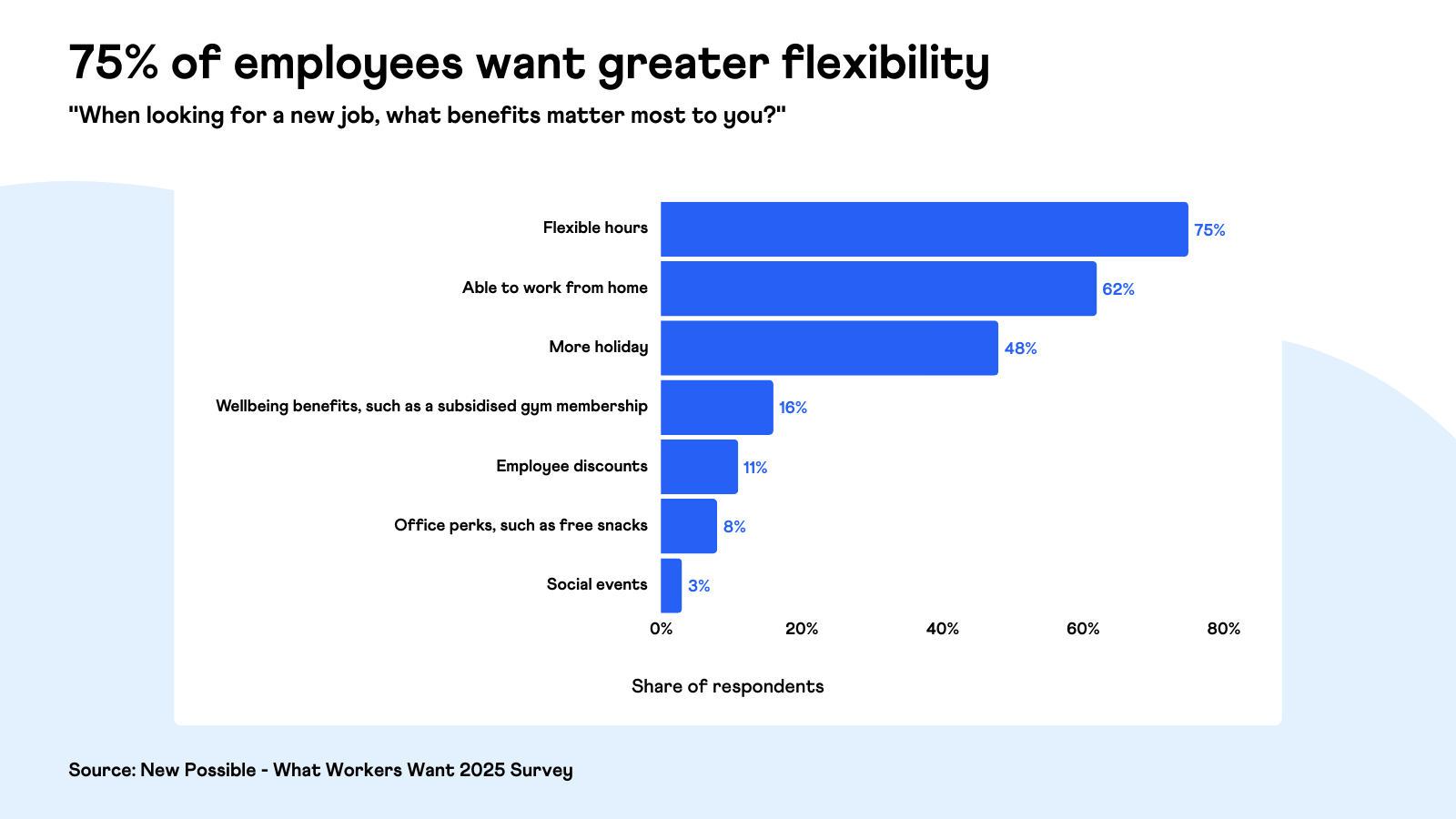
When asked about what benefits matter most when looking for a new job, flexible hours (75%), working from home (62%) and more holiday (48%) emerged as the top three choices - remaining in-line with 2024.
Differences by age reveal that younger workers (18–24) are significantly more interested in social events (20%), while both 18–24 and 25–34 year olds have a greater preference for office perks like free snacks (40% and 13%, respectively). Demand for flexible hours peaks among those aged 35–44 (79%), whereas older workers (65+) are less inclined to work from home (28%) and more likely than average to value employee discounts (17%).
30% of employees say their wellbeing has declined over the past year
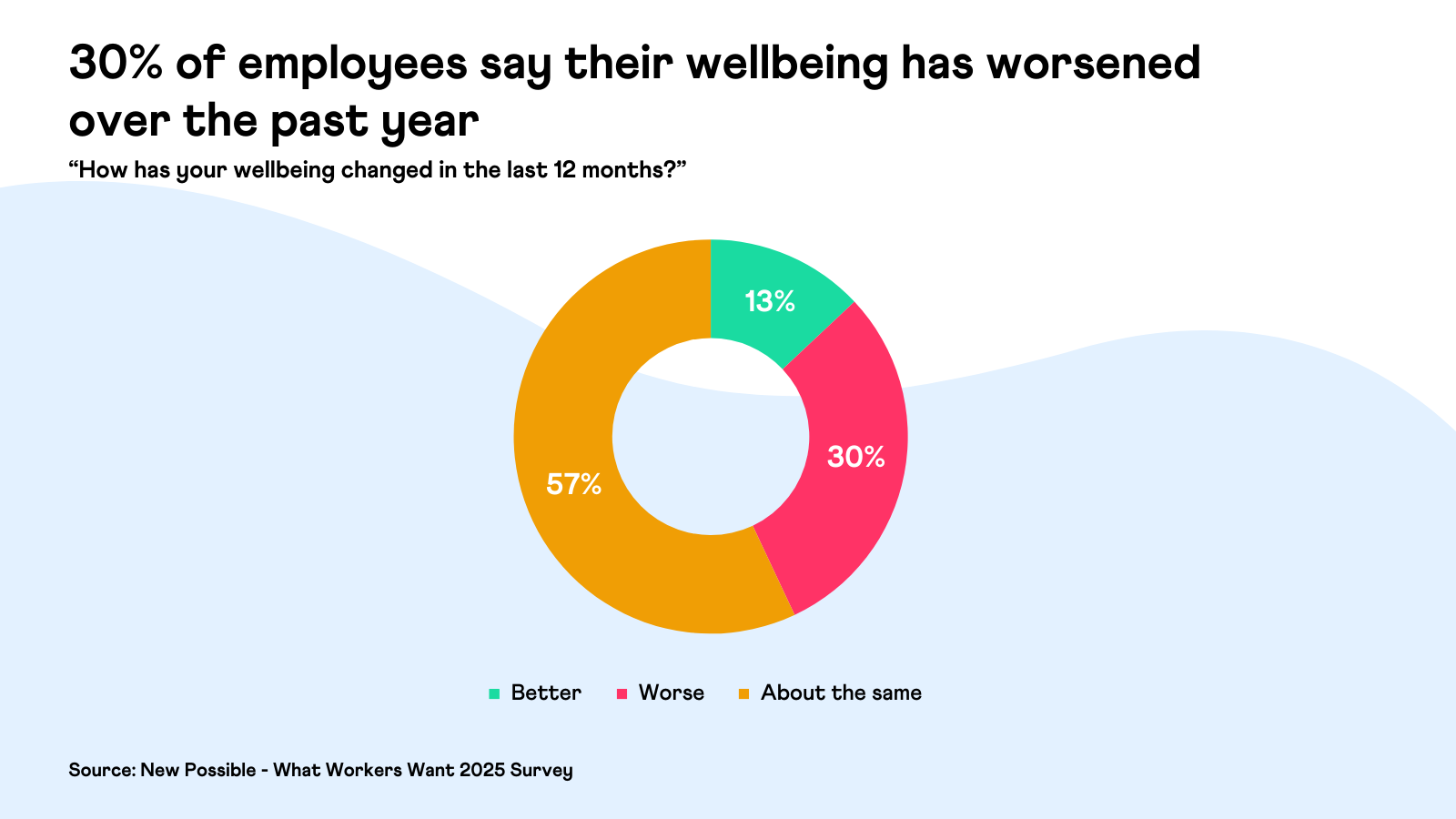
30% of employees report a decline in their wellbeing - down slightly from 32% in 2024 and 34% in 2023.
Over the past 12 months, those in transport and logistics (45%), IT (40%), sales (40%), and retail (35%) have experienced the sharpest fall in wellbeing.
14% of employees think they are at risk of redundancy in the next 12 months
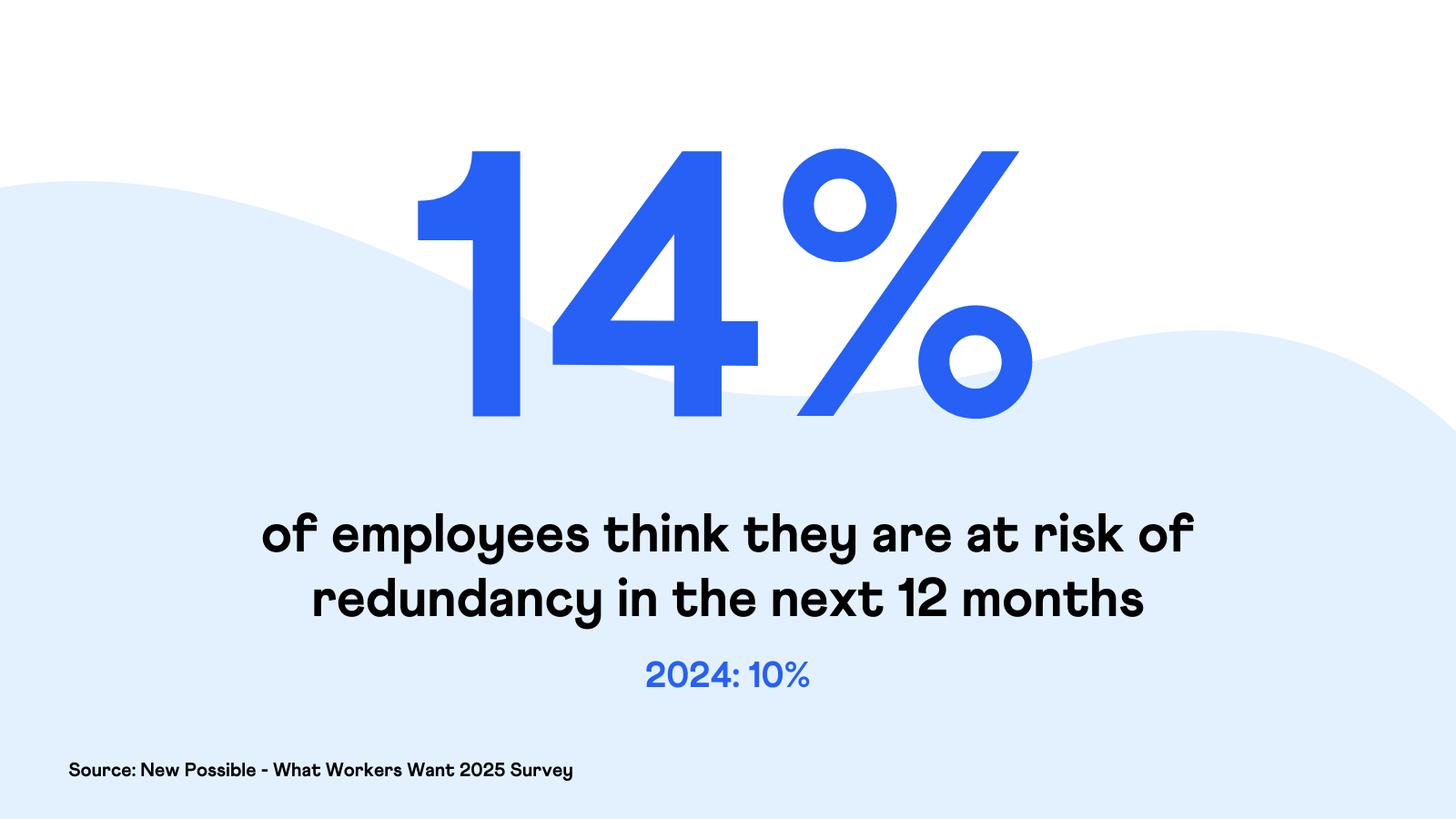
14% of employees believe they are at risk of redundancy in the next 12 months (vs. 10% in 2024).
Those in banking and finance (30%), creative arts (30%), marketing (20%), public services (20%), and IT (19%) are most concerned about redundancy. In contrast, employees in social care (1%) and healthcare (6%) feel the most secure.
46% of 35-44 year old's plan to look for a job in the next 12 months
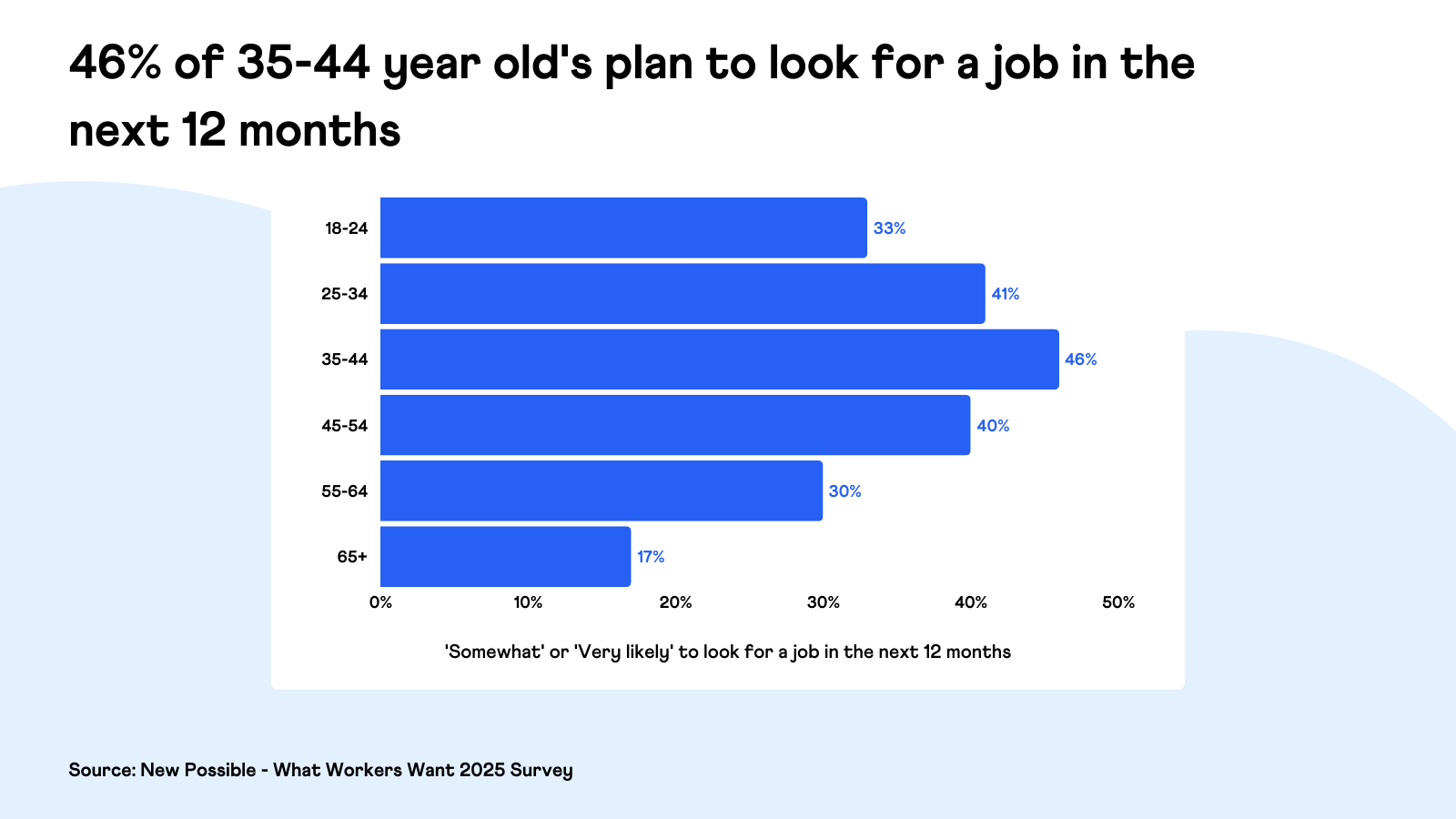
Pay and workload appear to be the main drivers behind 35-44 year old's leaving, cited by 18% of those intending to move.
Among younger employees, colleague relationships play the biggest role: 44% of 18-24 year olds and 37% of 25-34 year olds who plan to stay attribute positive colleague relationships as a top reason. In contrast, older employees are more likely to value work that's interesting and meaningful - 18% of 55-64 year olds and 24% of those 65+ say it’s their main reason for staying.
Industry Comparison
Average job satisfaction across all sectors remains at 70%, in-line with the previous two years. Engineering, manufacturing, and charities report some of the highest satisfaction levels, while healthcare, retail, transport and logistics rank at the lower end.
Overall, the likelihood of employees leaving increased across most sectors, with the exception of law, public services, property and construction.
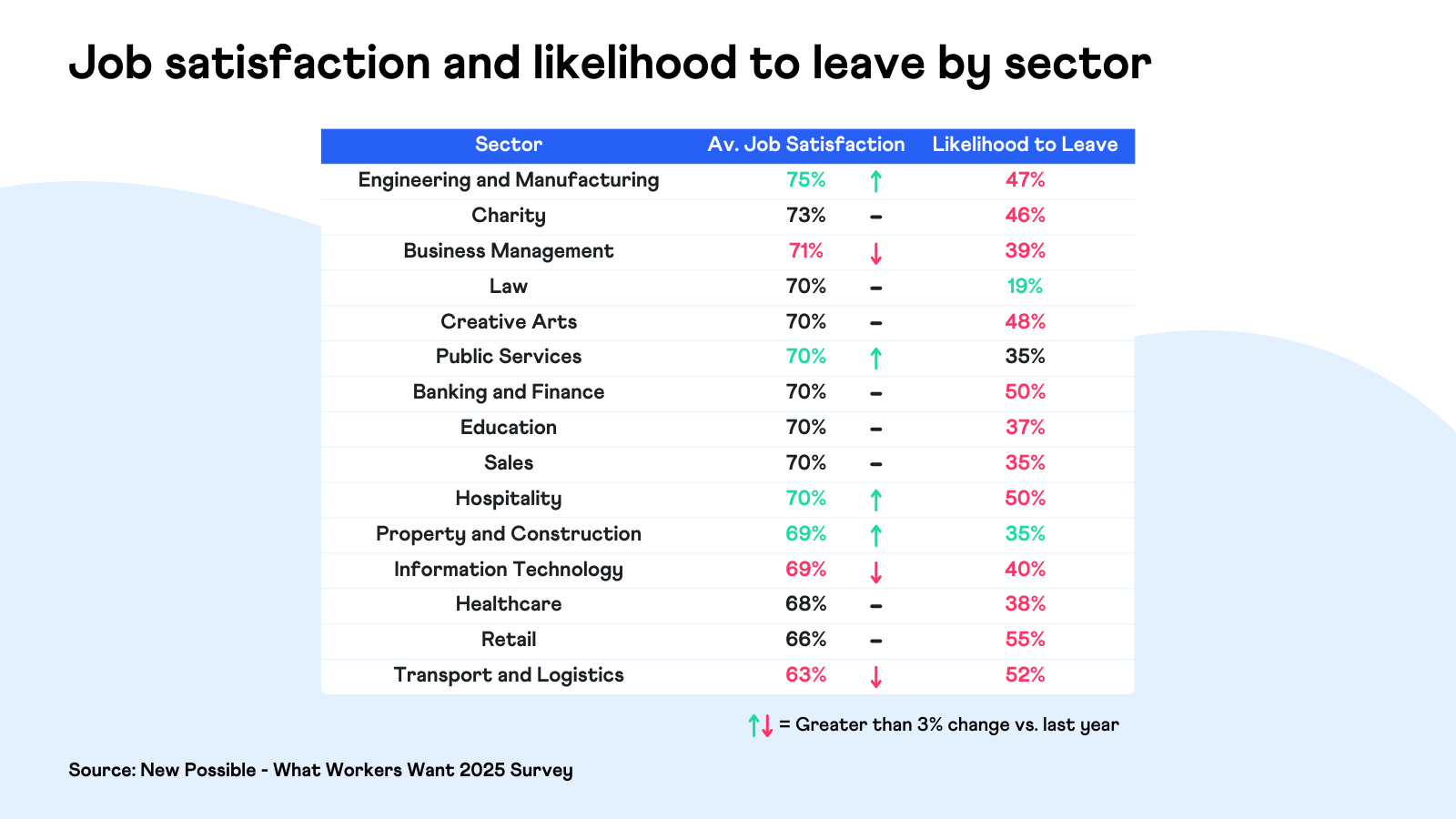
In a notable shift, IT - previously the most satisfied sector in 2024 - now reports growing dissatisfaction, with particular frustrations around pay and work-life balance. Contributing factors include tech skill shortages, mounting pressure to implement AI infrastructure, and increasing cyber security demands.
Meanwhile, retail registers the highest likelihood of turnover and remains near the bottom of the table, with issues including workload, leadership, and pay.
About New Possible
New Possible is the people insight platform that’s committed to your success. We work with a range of sectors to provide clear, actionable, and benchmarkable insights across the employee lifecycle. Our NP360 survey helps leaders gain meaningful insight into the broader people experience, measuring 7 themes, including satisfaction, culture, and wellbeing. Read about our mission, or book a demo to learn more.
If you’d like to discuss this research further, please email hello@newpossible.io or call 0161 706 0618.
Notes
New Possible’s What Workers Want survey captured responses from 2,014 UK employees between November 22nd and December 13th 2024. Research by Nate Harwood and Ava Kaveh.

